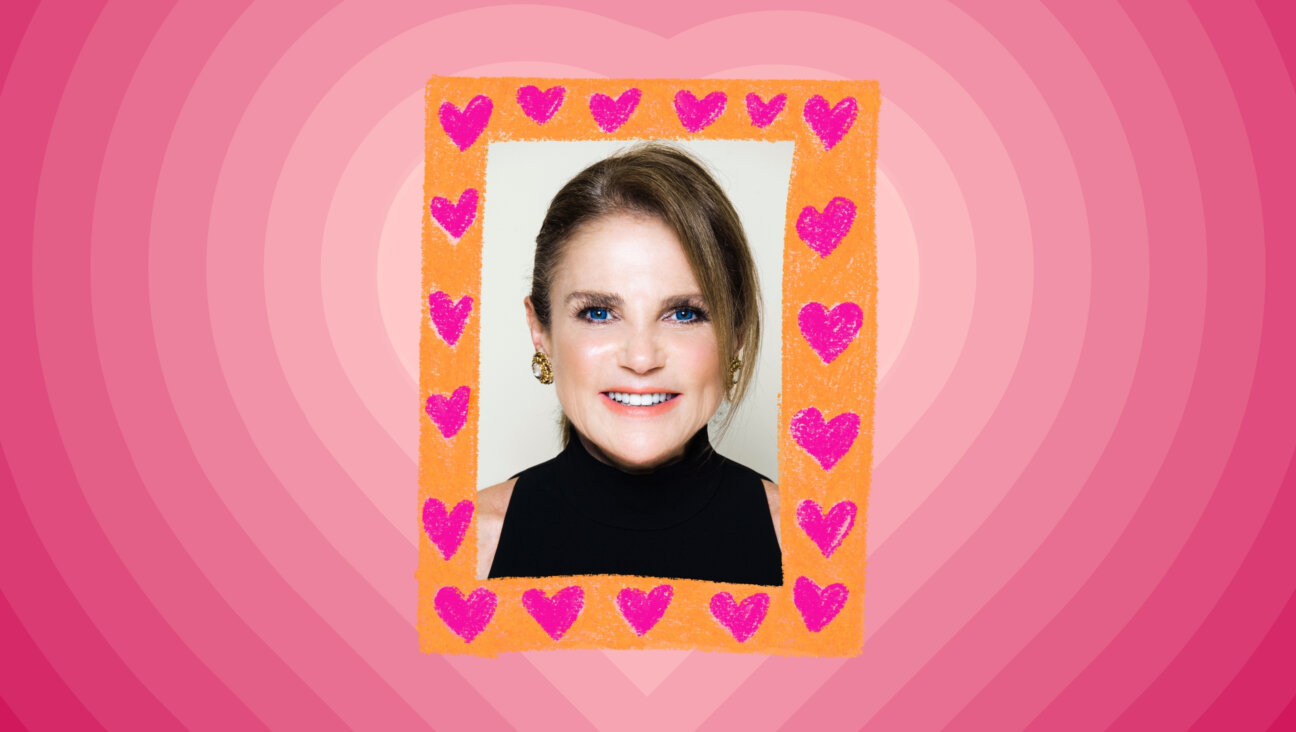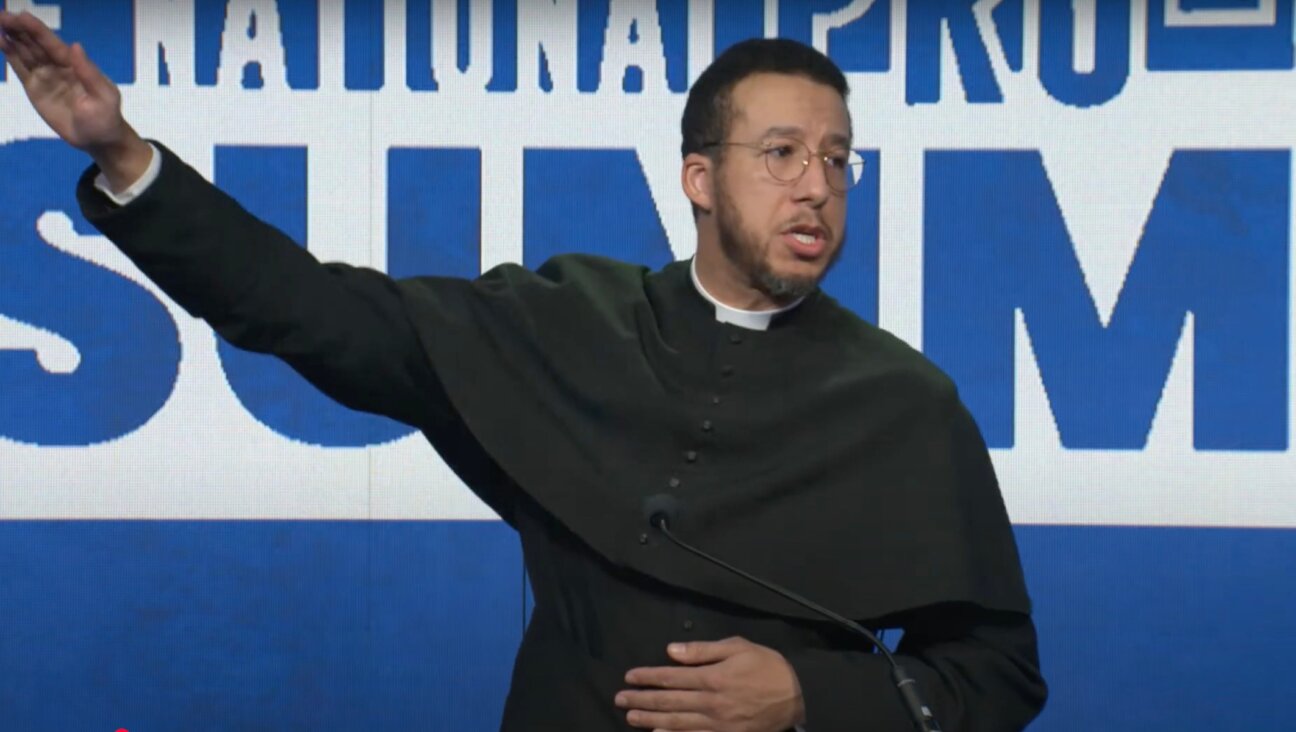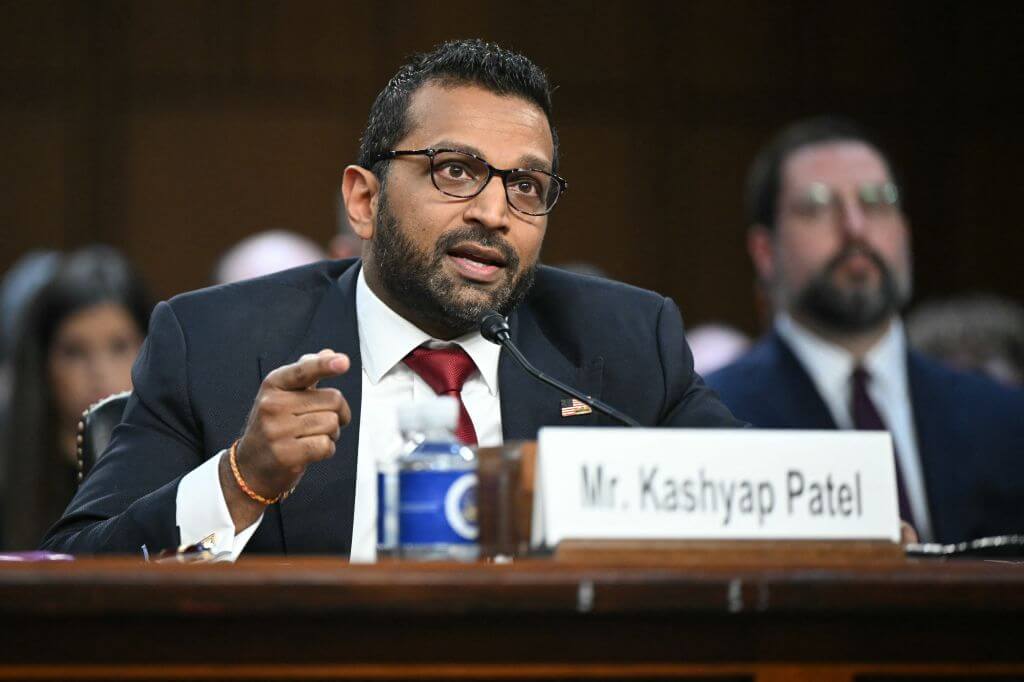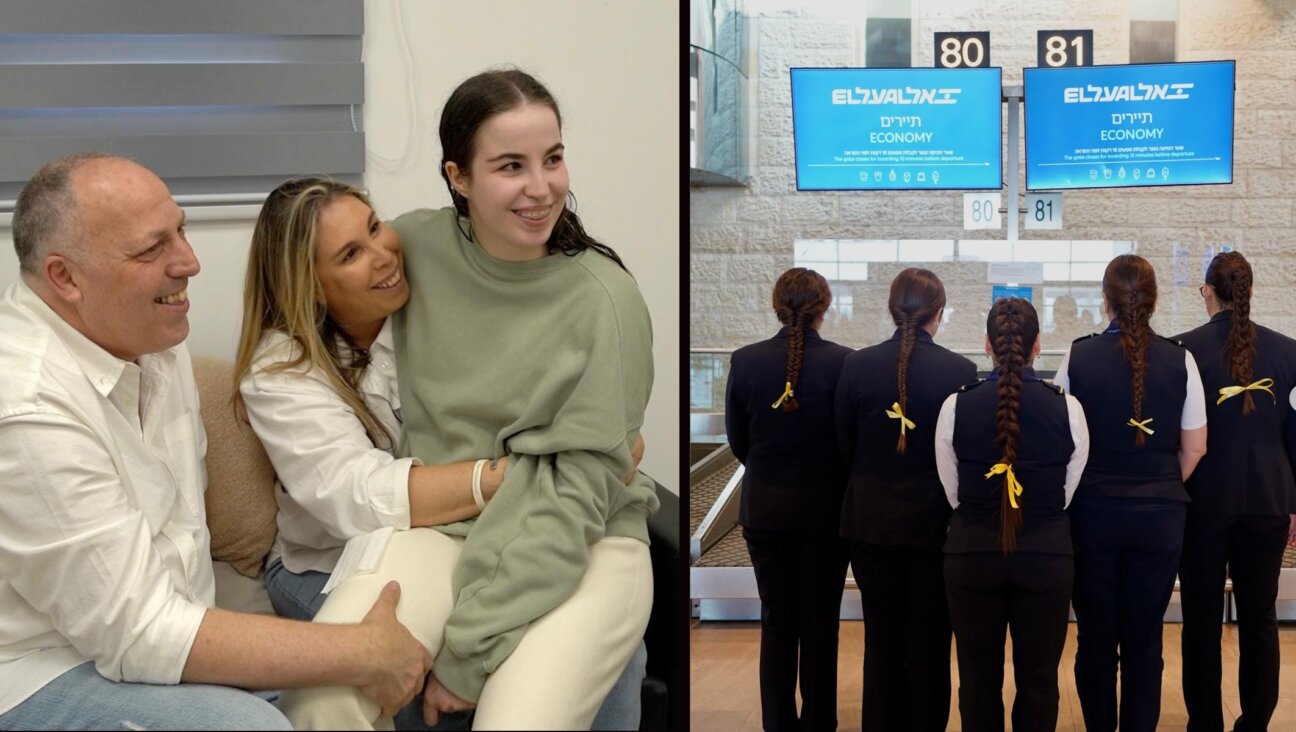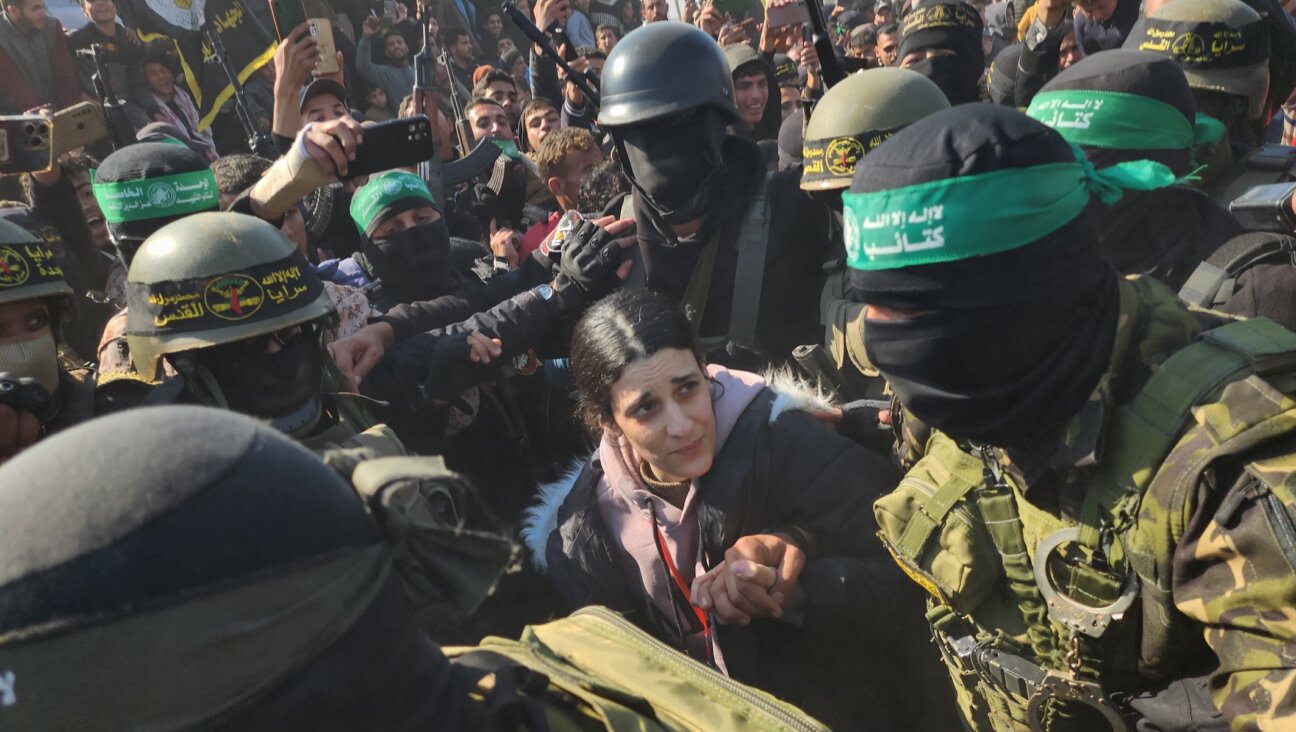Every Jewish thing you need to know about Batman (and there’s a lot of it)

Overlooking Gotham: Cosplayer Dom Charland, dressed as Batman, surveys his domain at the Edge, the outdoor sky deck at Hudson Yards. By Getty Images
“The Batman,” starring Robert Pattinson, is the 11th live-action film for the Caped Crusader. He’ll also return later this year in “The Flash,” where both Michael Keaton and Ben Affleck reprise their roles as alternate dimension versions of the character.
Batman is the property of DC Comics and parent company Warner Bros. He’s one of the most popular and profitable superheroes in the world. He’s also heavily Jewish.
His mythology may not borrow from scripture and Yiddishkeit like Superman’s does, particularly during the season of Purim — a holiday of costumes and masks, celebrating what may be the earliest case in literature of a heroic secret identity.
BAT ORIGIN

Citizen Kane: American cartoonist Bob Kane, originator of Batman, sits on a couch in his apartment surrounded by Batman collectibles, including posters and action figures. By Getty Images
Batman (originally “The Bat-Man”) debuted in May 1939’s Detective Comics #27. He was created by artist Bob Kane (Robert Kahn) and writer Bill (Milton) Finger (who also co-created Green Lantern), in response to the runaway success of the first superhero, Superman, the year prior, by the same publishers. Batman became the yin to Superman’s yang, and pretty much every superhero since can be placed somewhere on the spectrum between the two.
As legend has it, Kane and Finger developed Batman over a single weekend. Kane came up with the name and the initial concept, purportedly inspired by Leonardo da Vinci’s ornithopter. His initial design included a red bodysuit, black trunks, small domino mask and batlike hang glider wings.
On the suggestion of Finger, the costume became gray and black with blue highlights, with a bat chest emblem, serrated cape and a cowl with pointed ears. Finger also conceived the alter ego of millionaire playboy Bruce Wayne and his tragic origin story.
Batman wasn’t an original character. He was a Frankenstein’s monster stitched together almost entirely from preexisting ideas, but one so good that he surpassed them all. Kane and Finger based him, visually and conceptually, on the film “The Bat Whispers” and pulp magazine characters the Black Bat, the Shadow and Zorro. (The latter two were inspired in turn by the Scarlet Pimpernel, who also inspired Swedish diplomat Raoul Wallenberg to save as many as 100,000 Hungarian Jews from the Nazis.)
Kane and Finger were both Jews of Eastern European descent, Finger a first-generation American and Kane a second. Both lived in the largely Jewish South Bronx, where they attended DeWitt Clinton High together, along with other future comics luminaries Will Eisner, Irwin Hasen and Stan Lee.
Batman’s publisher, DC (named after “Detective Comics,” Batman’s home title), was owned by Harry Donenfeld and Jack Liebowitz (Yakov Lebovitz), Jewish street toughs from the Lower East Side turned entrepreneurs. They also published nudie mags, and before that Donenfeld made his living bootlegging moonshine during Prohibition. He was friends with Frank Costello, head of the Luciano crime family.
Comic books weren’t quite as cutthroat, but they were a hard business. There are different versions to the story, but as detailed in Arie Kaplan’s “From Krakow to Krypton: Jews and Comic Books,” Kane managed to obtain ownership stake in his character, extremely rare at the time, by lying that he was underage when he’d signed the contract, forcing DC to renegotiate.
Unfortunately for Finger, who worked with Kane as a hired ghostwriter, not a partner, Kane received sole credit, legally and in the byline, as the creator of Batman.
Despite Finger’s contributions, including co-creating Robin, Joker, Penguin, Catwoman, Two-Face, Commissioner Gordon, the Batmobile, bat-gadgets, Gotham City and much else, he was denied any recognition by Kane until after his death. Kane became a rich man, hobnobbing with the likes of Sammy Davis Jr., Muhammad Ali, Francis Ford Coppola and Fidel Castro. Finger became an alcoholic, dying penniless and obscure at age 60 in 1974.
Eventually, Finger’s credit was restored following continued acknowledgment and lobbying by industry professionals. Since October 2015, all Batman comics and media appearances have been labeled “Batman created by Bob Kane with Bill Finger.” In December 2017 he even got a street named after him, Bill Finger Way, on East 192nd St. & Grand Concourse in the Bronx.
BAT CARETAKERS

The Ears Have It: Julie Newmar as Catwoman, circa 1966. By Getty Images
Batman had many other Jewish stewards, including artist Jerry (Sherrill) Robinson, co-creator of Robin and the Joker; Julius Schwartz, who was the Bat-editor for 14 years; Paul Levitz, who succeeded Schwartz in 1978 and helped return the Dark Knight from the 60s camp to his noir roots, later becoming DC president and publisher; and Jenette Kahn, a rabbi’s daughter who was DC’s publisher, president and editor-in-chief from 1976 to 2002.
In 1979, a Jewish entertainment lawyer from New Jersey named Michael Uslan — a childhood Batfan who’d also taught the first accredited college course on comics in 1972 — partnered with producer Benjamin Melniker to buy the movie rights from a disinterested DC. It took him another decade to get a studio on board, but the result was the 1989 megahit “Batman,” starring Michael Keaton.
Uslan has served as executive producer on every Batman movie since, including “The Batman.” He recounts his own heroic quest in the book “Batman’s Batman: A Memoir from Hollywood, Land of Bilk and Money.”
Batman’s cinematic history includes several other noteworthy Jewish contributors, including screenwriter Akiva Goldsman and director Joel Schumacher, who subjected audiences to the risible “Batman Forever” and “Batman & Robin,” and David Goyer (despite the surname, also Jewish), cowriter of the Christian Bale trilogy.
There’s also been some notable on-screen representation including the 2014–2019 TV series “Gotham” starring David Mazouz as Bruce Wayne; 2019’s inexplicable hit “Joker” starring Joaquin Phoenix; and, more interesting, Zoë Kravitz’s performance as Catwoman in “The Batman.”
BAT THEMES

Back in Black: 1991: Actor Michael Keaton as Batman on set during the filming of “Batman Returns” in 1991. By Getty Images
Bob Kane himself seemed to have an ambivalent or indifferent attitude toward his Jewishness. He grew up, socialized and worked in a predominantly Jewish milieu, but as Danny Fingeroth points out in “Disguised As Clark Kent: Jews, Comics, and the Creation of the Superhero,” he never mentions being Jewish in his autobiography, “Batman and Me,” except for a telling mention of a home-cooked meal of matzo ball soup and chopped liver.
Bruce Wayne was something of a personal avatar for Kane, modeled after himself (or perhaps the other way around). They shared similar names, Bruce Wayne and Bob Kane, and both smoked pipes and wore ascots. Kane aspired to WASPiness (even legally changing his name) and Wayne was his means, both through fantasy and the riches he brought.
Catwoman was also modeled after real-life women, including Jewish movie star Hedy Lamarr (Hedwig Kiesler) and allegedly Kane’s cousin, Ruth Steel.
Kane and Finger were friends with Superman co-creator Jerry Siegel, and Fingeroth theorizes that the Waynes’ murder may have been inspired by the death of Siegel’s father, who suffered a heart attack while his store was being robbed. But in “Up, Up and Oy Vey: How Jewish History, Culture and Values Shaped the Comic Book Superhero,” Rabbi Simcha Weinstein sees their murder as a reflection of the Jewish fear, particularly at the time and especially after Kristallnacht, of safety and security shattered by violence, as Jews were being gunned down in the streets of Europe against a backdrop of gothic architecture.
Either way, as was the case with Superman and Batman, most superheroes were orphaned of at least one, though usually both, of their parents, usually by violence. A short list includes Robin, Captain Marvel, Flash, Aquaman, Green Lantern, Captain America, Spider-Man, Iron Man and Daredevil.
OTHER JEWISH THEMES AND PREOCCUPATIONS
In WWII, like the rest of the superheroes, most of which were created by Jews, Batman enlisted to fight the Nazis. In Batman #14, for example, he busted a Nazi spy ring. On the cover of Batman #18, he hawked war bonds and stamps while blowing a giant dynamite stick in the faces of Hitler, Hirohito and Mussolini.
In the landmark 1988–1989 “A Death in the Family” in Batman #426–429, the Joker steals a nuclear missile and tries to sell it to Lebanese terrorists who plan to blow up Tel Aviv. When Batman foils the plan, Ayatollah Khomeini appoints the Joker as the Iranian ambassador to the U.N. (which, given the regime, is only slightly more bonkers than reality).
The Clown Prince of Crime gives a speech at the General Assembly in which he equates Iran’s fundamentalism with his own insanity, then predictably tries to kill everyone with his laughing gas. Superman shows up to save the day.
A two-issue story in 1991’s Detective Comics #631–632, “The Golem of Gotham,” is essentially a retelling of the Golem of Prague. It introduces the Jewish neighborhood of East Hamilton, beleaguered by white supremacists. An orthodox Holocaust survivor creates a golem for protection, and the golem gets out of hand, goes on a killing rampage and is stopped when the letter “E” is erased from its forehead.
There’s also a twisted Moses allegory hidden in 1992’s “Batman Returns,” where the Penguin is given an origin story as a baby tossed into a river in a wicker basket because he’s too ugly, who grows up to plot revenge by abducting and killing all of Gotham’s firstborn sons.
BATMENSCH
A funny thing happened on the way to the Batcave: Bruce Wayne accidentally became Jewish. In September 2006 DC introduced a new Batwoman, a reconceived version of a 1956 character, named Katherine Rebecca “Kate” Kane, in honor of Bob Kane. She is Bruce Wayne’s maternal cousin, and has been shown celebrating Hanukkah and reading Jewish esoterica. Kate’s deceased mother, Gabrielle, is only implicitly Jewish (though it’s explicit in the “Batwoman” TV show, which also gave her the maiden name Goldstein), but unless her father converted, which hasn’t been mentioned, that would make Martha Jewish too. And since Jewish affiliation is matrilineal, that makes Bruce Wayne Halachically Jewish.
However, in October 2018’s Batman Vol. 3 #53 Bruce Wayne discusses his father’s Christian faith, revealing that they’d attended church, and declares his atheism. Pointedly though, he says “my father was a Christian,” not “my parents.” And when his butler and confidant Alfred dies, in February 2021’s Detective Comics #1033 Bruce places a stone on his headstone, a Jewish custom.
This isn’t a lot to go on, and Bruce probably works better as a rich, sheltered WASP whose world is torn apart when his parents are murdered, but one thing DC did bother to make clear, for some reason — he’s circumcised.
OTHER BAT JEWS
Batman also has one of the most Jewish supporting casts in comics. There’s Ragman, aka Rory Regan (Reganiewicz), a fellow Gotham crimefighter with a connection to the Golem of Prague. There’s also Tim Drake, the third Robin, who, according to online murmurings, was intended to be revealed as Jewish, but that never happened.
Whistle, a new Gotham City hero who debuted in September 2021, is not just openly but prominently Jewish, a high School student named Willow Zimmerman who lives in Down River, based on the Lower East Side, replete with an Eldridge Street Synagogue lookalike.
The most prominent Jewish character in Batman’s world is Harley Quinn, a villain-turned-antihero from Bensonhurst, Brooklyn. Debuting in 1992’s “Batman: The Animated Series” as the Joker’s girl Friday (at least we know he isn’t an antisemite), she was based on and voiced by Jewish actress and comedian Arleen Sorkin, who gave her Borscht Belt humor, a stereotypical Brooklyn accent, and pepper her dialogue with “oy” and “plotz.” According to DC’s publisher and CCO Jim Lee, she’s the company’s most popular character after Superman, Batman and Wonder Woman.
BAT SCHMUCK
Batman also had a major Jewish supervillain, but this one in real life.
Dr. Fredric Wertham (Wertheimer), a German-born Jew, was an eminent forensic psychiatrist. Among other positions, he was the senior psychiatrist for the New York Department of hospitals and head of the Court of General Sessions (State Supreme Court) psychiatric clinic.
He was also a prude who fancied himself a cultural critic and moral authority, and he used his credentials to validate his personal opinions. He looked down on all forms of mass culture, but hated comic books with a passion.
Riding the wave of postwar paranoia about juvenile delinquency, in 1954 he published the book “Seduction of the Innocent: The Influence of Comic Books on Today’s Youth,” in which he accused comics of turning otherwise well-adjusted children into violent hooligans.
Much of his evidence focused on subtext, and Batman particularly proved fertile. “Batman stories are psychologically homosexual,” he declared. Conflating homosexuality with pedophilia, he stated that they “fixate homoerotic tendencies by suggesting the form of an adolescent-with-adult…type of love-relationship.” His evidence? Robin’s real name is “Dick,” and he shares “an idyllic life” with Bruce Wayne in “sumptuous quarters, with beautiful flowers in large vases.”
It sounds farcical, but the book became a runaway best-seller and sparked mass hysteria. Comics were rounded up and burned in public pyres across the U.S., by the same people who’d just fought against the book burners of Berlin.
A Senate Subcommittee on Juvenile Delinquency was formed, its hearings making front page and primetime news nationwide. Wertham testified on the first day, announcing theatrically that “Hitler was a beginner compared to the comic book industry.” Here was a Jew, calling a mostly Jewish industry worse than Nazis, not a decade after the Holocaust. And these assertions were made in the wider context of McCarthyism, which predominantly targeted Jews. It didn’t take long for thinly veiled antisemitism to show up, with WASP publications like the Hartford Courant calling comics “the filthy stream that flows from the gold-plated sewers of New York.”
BAT CONTROVERSIES
Two Batman works have even been accused of antisemitism.
When “Batman Returns” came out, The New York Times ran an op-ed asserting that the Penguin (Danny DeVito) was a blatantly antisemitic caricature. “He is a Jew, down to his hooked nose, pale face and lust for herring,” it read. There was also his accomplice, a corrupt businessman with a purportedly Jewish-sounding name, Max Schreck (Christopher Walken).
A few other publications jumped on the bandwagon, but the ADL rightfully dismissed the claims as “nonsense.” Director Tim Burton bestialized the Penguin in his signature carnival grotesquery, which may be similar to how antisemitic tropes dehumanize Jews, but he didn’t draw from them.
A bit harder to brush off is the 2019 kerfuffle over the “Harley Quinn” adult animated show on HBO Max. Despite its mostly Jewish writers room, one episode revealed that the Penguin is, in fact, Jewish, essentially validating the Times op-ed’s claims. Worse, he attends his bucktoothed nephew’s bar mitzvah, the theme of which is “money.”
In another episode, Poison Ivy’s elderly landlord, the bionic Sy Borgman (get it?), played by Jason Alexander, dabbles in “Jewish lightning.” In a cringeworthy comment on a now-deleted Twitter thread by the character’s co-creators (none Jewish), DC artist Cully Hamner referred to him as “Half man, Half Jew.”
“THE BATMAN”
In the new movie, the penguin is a manifestly Italian mobster (he’s basically Joe Pesci, though he’s played by handsome Irishman Colin Farrell under thick makeup). Aside from Uslan and Kravitz, there’s nothing particularly Jewish about “The Batman.”
It’s also NOT for kids. It’s PG-13 but it borders on R, with some gruesome scenes that just barely make it.
Co-written and directed by Matt Reeves, it’s a relentlessly grim noir film, with a stylized realism reminiscent of “Se7en.” It’s beautiful, but it can be straining over the three-hour runtime.
It’s also truer to the comics than any previous film. Batman is “the world’s greatest detective,” and this is much more an intricate crime mystery than an action spectacle.
It’s a good movie. Maybe very good. It’s not as fun as 1989’s “Batman” (or at all, really) or as accomplished as 2008’s “The Dark Knight,” but it beats the rest.
So if you’re still looking for a Purim costume, consider a Hebrew hero. Be Batman.
Roy Schwartz is the author of “Is Superman Circumcised? The Complete Jewish History of the World’s Greatest Hero.” Follow him on royschwartz.com and Twitter, Instagram and Facebook @RealRoySchwartz.
A message from our Publisher & CEO Rachel Fishman Feddersen

I hope you appreciated this article. Before you go, I’d like to ask you to please support the Forward’s award-winning, nonprofit journalism so that we can be prepared for whatever news 2025 brings.
At a time when other newsrooms are closing or cutting back, the Forward has removed its paywall and invested additional resources to report on the ground from Israel and around the U.S. on the impact of the war, rising antisemitism and polarized discourse.
Readers like you make it all possible. Support our work by becoming a Forward Member and connect with our journalism and your community.
— Rachel Fishman Feddersen, Publisher and CEO







